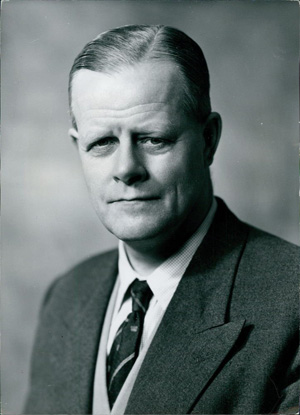
ROYAL NAVY HARBOUR DEFENCES - SOUTH AFRICA
 |
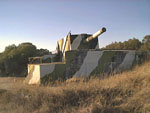 |
 |
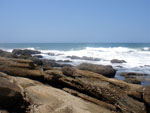 |
| Robben Is. quarry | Robben Island guns | Naval Map 1942 | Umhlanga Rocks |
On 6th September 1939, the Union of South Africa declared
war on Germany, but its military forces were hardly prepared. In January 1940 the Royal Navy handed over responsibility for the four Union Ports at Capetown, Port Elizabeth, East
London and Durban to the newly formed South African "Seaward Defence Force" (SWF). In 1942 the Union Government decided to
provide antisubmarine defences for these ports and approached the British Admiralty to supply the
equipment and personnel for installation and training. This web page looks at
the the process and problems.
 |
If you worked there or have any feedback please email me: Dr Richard Walding Research Fellow - School of Science Griffith University Brisbane, Australia Email: waldingr49@yahoo.com.au |
LINKS TO MY RELATED PAGES:
ANTISUBMARINE DEFENCES IN SOUTH AFRICA
In 1939 the four ports of the Union - Cape Town, Port Elizabeth, East London and Durban - were
defended by batteries manned from the Permanent Force Artillery. Cape Town itself was covered by two short-range 9.2 inch guns (22000 yard range),
and at the naval port of Simon's Town (30 km to the south in False Bay) by two of similar type and two 9.2 inch guns of improved design
(33000 yard range). At Cape Town three long-range 9.2s were planned for Robben
Island to guard the approaches to Table Bay but these were not in position until
November 1940. At Durban there were two semi-obsolete 6-inch guns, at Port
Elizabeth two 5-inch, and at East London two 6-inch guns - all
short range and mounted on field carriages. At the port of Walvis Bay 1600km to the north of Cape Town (now in Namibia) there were also two 5-inch guns,
short range and also mounted on field carriages. In terms of naval firepower, by 1939
the Union of South Africa had no significant naval force. Prior to WW1 (in 1910,
when the four colonies united) both the Cape and Natal had possessed active
divisions of the Royal Naval Volunteer Reserve, which were amalgamated by the
Defence Act of 191 to form the South African Division - Royal Navy Volunteer
Reserve (RNVR).
Naval Training
During WW1, South Africans
served in ships of the RN all over the world, guarded docks and Admiralty
property and manned the coastal defences of Durban. In the early 1920s the RNVR
(SA) trained aboard the ship General Botha at Simon's Town. In 1922
the Union Government acquired two minesweeping trawlers and a survey ship and
established the SA Naval Service, only to see it abandoned in 1932 by the 'Gold
Standard' financial crisis. By September 1939 the RNVR (SA) had a strength of 70
officers and 900 men spread over the training bases of Cape Town, Port
Elizabeth, East London and Durban. These officers and men trained on a part-time basis
of about two weeks per year aboard on one of the RN ships. The RNVR (SA) was
expected to man shipping control and examination services at Union Ports should
war break out. Their duties also included provision of signalmen for shore
stations, guns' crews in merchant ships, and manning of 30 auxiliary
minesweepers and four armed merchant cruisers.
Antisubmarine defences
As for antisubmarine defences, in March 1939, the
Union Government issued a memorandum about procedures on the outbreak of war.
Thirty six trawlers and whalers would be equipped as auxiliary minesweepers, and
fifteen as antisubmarine vessels. Most of the ratings and many of the officers
needed were to come from the RNVR (SA), the balance from RN Reserves. When war
did come the RNVR (SA) was overwhelmed with volunteers but had no facilities for
training them. Training was to be very much on-the-job. By the second week of
September 1939, Naval Officers-in-Charge were installed, with staffs, at the
four principal commercial ports as previously named - Capetown, Port Elizabeth, East London and Durban. Officers and men were also
supplied for Port War Signal Stations (PWSS), Examination Services, and Naval
Control Services. The first three minesweepers were ready by 15th September 1939
and by the end of December there were 15, manned by RNVR (SA) members. It was
soon discovered that for legal reasons a new command (to be called the Seaward Defence Force) had to be set up. Enough members of the RNVR (SA) volunteered to
transfer that the new command was off-and-running by 15th January 1940 and took over the responsibility for the Port War Signal Stations, and the Examination Services from the Royal Navy.
Fortunately, for South Africa, there was a breathing space before the need for defence would become urgent,
but not without some scares beforehand.
First
attacks
By March 1940
disguised German raiders were making their way to the Cape. First was
Atlantis which sailed on 31 March 1940, soon followed by Orion (6
April), Widder (6 May), Thor (6 June), Pinguin (15 June)
and Komet (3 July). The Admiralty knew them as Raiders C, A, D, E, F and
B respectively. On 15th May 1940 the Seaward Defence Force had it's first success of
the war when the South African minesweeper MV Aristea detected and exploded a mine laid
by German raider Atlantis 6 miles off Cape Agulhas - a major shipping
route. The following map shows the location:
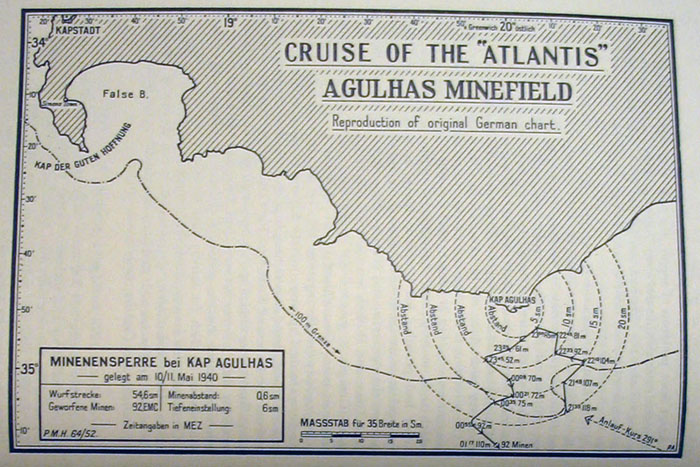
Harbour Defences
The enemy's use of magnetic mines in Europe resulted in the receipt of the following Admiralty message by the Senior Naval Officer, Simon's Town, dated 4 June 1940:
| It is desired to establish degaussing open ranges at certain Dominion and Indian ports. Information is requested whether Dominion and Indian naval authorities will undertake their establishment and operation. Instruments and stores not available locally will be supplied from United Kingdom. Instructions for laying already promulgated. Personnel for ranges one lieutenant, one civilian electrical officer and assistant, three recorders WRNS, two signalmen. In addition, one physicist per Dominion with necessary qualifications to analyse and make recommendations. Ranges in order of priority Halifax, Cape Town, Bombay, Sydney. Duplex later. If proposals concurred in Senior Technical Officer should report to Superintendent of Degaussing at Admiralty for training without delay, travelling by air. |
It should here be noted that the provision and maintenance of the suggested degaussing range had no direct connection with South Africa's defences, but was rather, a link in a world-wide service for the protection of shipping against magnetic mines. By accepting the cost of this commitment, which it did on 31 July after more information had been provided, the Union Government made its first external contribution towards the general Allied war effort. At first there was a question whether the Royal Navy should lay and operate the range, but it was soon decided that the SDF would do so, the Admiralty providing only such
Professor Brian Goodlet from the University of Cape Town was appointed technical advisor to the South African Defence Force in July 1941 to advise on deperming installations. As, even in Britain, this was quite a new branch and there had not as yet been time to train specialists to supervise the laying of DG ranges elsewhere, the services of Professor B.L. Goodlet, of the University of Cape Town, were obtained as Technical Adviser. He left for Portsmouth in August 1941 and spent several weeks absorbing the necessary first-hand knowledge and practical experience before returning to Cape Town in November that year.
With the likelihood of a dramatic
increase in shipping arrivals and enemy activity to South Africa in late 1942, the Union Government
stepped up its antisubmarine program at the recommendation of the British War Cabinet whose Subcommittee on Defence Arrangements for the Indian Ocean recommended fixed A/S defences for South African ports, particularly against Japanese midget submarine. The Committee noted that Durban was the most vulnerable given the midget attack on Sydney Harbour and Diego Surez by the Imperial Japanese Navy in May 1942. Laying of loops was expected to begin immediately but there was none to be had as it was all ear-marked for Australia. Goodlet was called on again to assist. Because of the shortage of materials Goodlet had to manufacture equipment locally. The following biograph of Professor Goodlet put this all in to perspective.
Professor Brian Laidlaw Goodlet was born in Petrograd (St Petersburg), Russia on 13 March 1903 of British parents who had settled there in the service of the Government. He attended the Imperial School in St Petersburg. It was here that he learned "my arithmetic in German, my algebra in Russian and my calculus in English"[1]. At 14 he shot his way down Nevsky Prospect (the main street of Petrograd) trying to avoid death during the 1917 Russian Revolution. He left Russia in 1918 for England and in 1922 he started as a trade apprentice with the British heavy electrical engineering company Vickers Ltd at their Attercliffe works at Sheffield. In the meantime he continued his education at the local University and was awarded an Associateship in Electrical Engineering in their Applied Science Department. He was promoted to special trainee at Vickers Trafford Park Works. In 1924 he was appointed to sister company Metropolitan-Vickers Electric Company Ltd ("Metro-Vick") at Manchester as technical assistant and in 1927 a research engineer at their Million Volt Research Laboratory. In 1928 he joined the Institution of Electrical Engineers as an Associate Member - and began what was to be a lifelong affiliation. Goodlet was approached by physicist Sir Ernest Rutherford about the construction of equipment for the Cavendish Laboratory. Goodlet recommended a Tesla transformer of 500-600kV. The Metro-Vick physicist Tom Allibone recalls being invited to tea with Rutherford and Goodlet. He said that Goodlet had an extreme interest in military strategy and it was fascinating to hear him quote Napoleon's campaigns (he even wrote a paper on the ballistics of classical weapons). Rutherford had just come back from the British Association for the Advancement of Science (BAAS) meeting in South Africa (1929) and "was full of the Zulu wars, of which Goodlet had a profound knowledge. One mention of Lobengula and their enthusiasm and knowledge held us spellbound. Goodlet, to Rutherford's great delight, continued the story with intimate details of the part played by the Zulu's lieutenants" [12]. Goodlet's conversations with Rutherford would stand him in good stead when wartime problems arose. Rutherford later shared a Nobel Prize for this work (in conjunction with Sir John Cockcroft). Rutherford - at Cambridge - encouraged Goodlet to take the Engineering Tripos in Cambridge [2]. He was 27 and had received a very generous scholarship from the Company [3]. He was succeeded at Metro-Vick by Thomas E. Allibone, a former apprentice who had also attended Sheffield University. As a matter of interest, Goodlet had been tutored in mathematics at Sheffield by Allibone's father. On his return to Trafford Park after two years at Cambridge he began a study of extra-high voltage discharges from turbo-alternators culminating in his widely acclaimed lecture tour on "Lightning" for the Institution of Electrical Engineers. Goodlet presented the lecture on 7 January 1937 and said that he chose the title as a mark of respect for the Institution's 12th Kelvin Lecturer of 1929, Dr George Clark Simpson FRS of the Meteorological Office, who had used the same title. Goodlet said that in the seven years since Dr Simpson delivered his lecture more had been discovered about lightning than in the previous seventy years. Goodlet then undertook 3-month lecture tour of Britain, including Glasgow and Belfast. The paper was published in July that year - 1937 [4a]. He was made a Member of the Institution that same year for this great contribution. His responses to critics and commentators of his lectures and paper shows that he was a master of tact and his patient explanations displayed the makings of a good educator [4b]. When you look back at that paper today it is surprising how little has changed in the fundamental principles of lightning [4c]. In 1932 Goodlet married Norah McCormick, second daughter of Rev. T Eaton McCormick, vicar of Broadclyst, Devon, and they had two sons - Paul and Roger - and two daughters - Angela and Hilary. In 1937 Goodlet was appointed Professor of Engineering and Dean of the Faculty of Engineering at the University of Cape Town on a salary of £1000 pa rising by £50 every two years to a maximum of £1300. In April 1939 Prof. W. Cramp at Birmingham University died and the chair became vacant. Goodlet applied and was successful and began his tenure in October 1939. He offered his services to the Admiralty but because of his connections with Russia he was not accepted. He resigned in June 1940 and was replaced by his colleague from Metro-Vick Dr. Cecil Dannatt. Dannatt had been in charge of the Electrical and Magnetic Laboratory at Metro-Vick [5]. Nevertheless, Goodlet's old position as chair at Cape Town was still vacant so he applied and was accepted without delay. Professor Goodlet had a number of PhD candidates working under his tutelage at Cape Town. One was Heinz Einhorn. After several years of research into lightning Einhorn was awarded his doctorate and together they published a paper out of the PhD entitled "Lightning over-voltages in underground cables". This showed their familiarity with electromagnetic induction in underground cables from changing electrical and magnetic fields [6]. The South African government was left in no doubt as to who was best placed to take on one of their biggest challenges.
In 1941 Goodlet was tasked with the job of advising on deperming (or degaussing) installation for submarines. Deperming and degaussing are similar processes whereby the magnetism of a submarine is reduced so that it does not trigger magnetic mines such as those being laid by the Germans. Goodlet left Cape Town for Portsmouth Naval Base (England) in August 1941 gaining first-hand knowledge and training. He returned to South Africa in November 1941 to take over the Electrical Branch of the South African Defence Force (SDF) - which had been formed in late 1940. As the SDF possessed no technical officers, Prof. Goodlet had to recruit and train his own staff of three officers and nine ratings. He continued to serve as a civilian until receiving a commission as Electrical Commander, SDF [7]. In April he was seconded to the Royal Navy for special duties and replaced by his chief assistant Cdr A. L. James. Another scientist appointed to Goodlet's team was Godfrey Harry Stafford (1920-2013). Here is an obituary written by colleagues and friends for the CERN Courier Volume 53, No. 9, November 2013. Scroll down to p. 43. The following is an extract from Stafford's notes in which he describes his time in Goodlet's team.
Early in 1942, the British War Cabinet Sub-Committee on Defence Arrangements for the Indian Ocean Area made recommendations for various fixed underwater defences in South Africa. Included in these was the indicator loop for the detection of midget submarines which might invade the South African ports, of which Durban was considered the most vulnerable target. Indicator loops were long lengths of cable laid on the seafloor in shipping channels to detect enemy submarines by the electrical signal they generated in the loops. The Admiralty-pattern instruments included a specialised galvanometer for measuring the tiny currents produced (known as an integrator) and other equipment such as the cable, the chart recorders, amplifiers, and balancing boxes. None of this was then in this country, but the matter was so urgent that Cdr Goodlet was instructed to do what he could with materials obtained locally [8]. He had already done some experimental work of this kind, and although dredging operations delayed matters somewhat, his "Goodlet Loops" were working satisfactorily in the Durban entrance channel by the end of October. Had Rutherford still been alive (he died in 1937) Goodlet would have called on him for advice. Rutherford chaired the Admiralty's Board of Investigation and Research in World War I which developed the loops in the first place. The harbour defence installation at Durban consisted of two loops of electric cable [the link shows some typical samples], connected with a small control station on the roof of the South Breakwater where one officer and one rating kept continuous watch. Each circuit was connected to a fluxmeter (a modified galvanometer - essentially a galvanometer without a spring on the pointer) acting upon a photo-electric trigger relay which operated an electric bell when a submarine crossing took place. The system was sufficiently sensitive to detect an 80-foot wooden fishing boat with a steel keel and engine. In the event of an unidentified crossing, the outer loop provided a warning and the inner loop confirmed it. The galvanometers and photocells were Goodlet's own - borrowed from the University's Physics Department. The cable was spare communications cable. After a short time he was sent to England to work with the British Admiralty as Chief Scientist at Rosyth (near Edinburgh). Here he was Chief Scientist at the Underwater Explosions Research Station and made distinguished contributions to work in that field. He became famous for assisting with neutralising the German magnetic mine on the mudflats at Dagenham. His talent was obvious and he was appointed to the Far East Naval Task Force in Ceylon under Lord Mountbatten. The Queen awarded him an OBE in 1944, and his Cambridge post-nominal soon became MA (Cantab.). The rest of the story about the loops is continued after the end of this biography. At war's end he returned to Cape Town where he built up a vigorous engineering department. While serving with Mountbatten in the Far East he had seen the value for engineering of a better grounding in physics and mathematics than had previously been the case, and introduced a new engineering curriculum in the University of Cape Town. He was elected Member of the Royal Society of South Africa (FRSAA) in 1946 and Fellow in 1948 [9]. His 1951 textbook "Basic Electrotechnics" was a masterful treatment of the field and became the set text in 2nd and 3rd year Honours physics courses (at British universities at least). It ran to three editions over the following decade. In 1950 the Chairman of the Harwell Atomic Energy Research Establishment in England Sir John Cockcroft visited Goodlet in Cape Town to offer him an exciting new position in England, and he accepted. Goodlet returned to England later that year as Head of the Engineering Research and Development Division and Deputy Chief Engineer at Harwell Atomic Energy Research Establishment (AERE) [10]. This was at a critical time for nuclear energy in the UK: there was renewed interest in pwower generation using unenriched uranium. This required a lot of moderator and Goodlet designed a vertical stack of 1500 tons of graphite (referred to as Pippa) to achieve this. This was a major engineering feat and Goodlet was up to the task. In 1952 he handed over the design to the Production Division to produce Calder Hall. As Tom Allibone said "It is a tribute to Goodlet's engineering judgement that no major changes of design were necessary" [12]. In 1955, while at Harwell, he visited Geneva to attend the First International Conference on the Peaceful Uses of Atomic Energy, and then, before returning home, visited Russia as part of the eight-member delegation of the British Atomic Energy tea to "see what the Russian were doing" [his words]. This was his first visit to Russia since leaving in 1918. Goodlet was later acknowledged by AARE Chairman Sir John Cockroft as one of the two men (along with Tom Allibone) chiefly responsible for the design of the first British power reactors (that is, the Calder-Hall type). For his paper "Nuclear Reactors for Power Generation" [11] to the Institution of Engineers he was awarded the Thomas Hawksley Gold Medal [11b]. While at Harwell (1950-56) Goodlet became the well-respected chairman of the Naval Education Advisory Committee of the Admiralty (in 1952), offering advice on officer training, cadet entry, technical training of junior ratings, and the conditions of service of civilian teaching staff at the RN Colleges. He also had a lot to say about the training of engineers in Britain, France, Germany and Russia (not all complimentary to Britain) [1]. His knowledge and strong opinions of technical training around the world enabled him to make great contributions to the Naval Education Service most notably the rehabilitation of the Dockyard Technical Colleges and curriculum changes to allow for modern developments in science and technology. On 1 April 1956 Goodlet resigned from Harwell to join the Brush Electrical Engineering Company as chief engineer and director, becoming managing director the following year. He was also a director of Hawker Siddeley Industries and of Hawker Siddeley Brush Turbines Ltd. His work with the Institution of Electrical Engineers was legendary: being awarded an Extra premium in 1929 and 1942; the the Kelvin Premium in 1931 for a joint paper "Dielectric phenomena at High Voltages (with F. R. Perry) and again in 1934 for his paper "Electromagnetic phenomena in high-voltage testing equipment", and an Overseas premium in 1937. He was also recognised by fellow engineers: a Thomas Hawksby Gold Medal by the Institution of Mechanical Engineers (as mentioned before), and the Trevithick Premium by the Institution of Civil Engineers [12]. His last professional problem was to do with vibration in the 30MW turbines at Brush Electrical. These were installed before Goodlet arrived so it was big challenge and solved satisfactorily due to his own perseverence before his death. He submitted his published work to Cambridge. He had developed new measuring techniques in solving the problem and so it was a major contribution of new knowledge. He was awarded his DSc in 1958. Brian Goodlet died on 27 October 1961, at the age of 58 at his home in Quorn, Leicestershire, England and was buried at St Batholomew's, Quorn [13]. His colleague and obituarist Richard Valentine Moore described him as a shy and sensitive man, an admirable leader, a delight to work with and highly intelligent, with generosity of spirit and integrity of purpose. Dick Moore worked with Goodlet on neutralising the magnetic mine on the Dagenham mudflats in 1940 and on the Pippa nuclear reactor from 1950-56. Moore became director of reactor design at the UK Atomic Energy Authority and managing director of the establishment's reactor group when Goodlet resigned to go to Brush Electrical. He knew Goodlet exceedingly well and in his obituary said that Goodlet could reduce complicated problems to their simplest form, and quoted Goodlet's favoutite Persian proverb "The dogs bark but the caravan moves on" [12]. Dr Richard Walding PhD 1. B. L. Goodlet O.B.E., M.A., M.I.C.E. (1956) The education of engineers in Russia, Journal of The Royal Central Asian Society, 43:3-4,200-212 |
Some of the following repeats text in Goodlet's biography but is used here for continuity.
Early in 1942, the British War Cabinet Sub-Committee on Defence Arrangements for the Indian Ocean Area made recommendations for various fixed underwater defences in South Africa. Included in these was apparatus for the detection of midget submarines which might operate against the ports, of which Durban was considered the most vulnerable target. There, the closing of the long entrance channel would have been more easy to effect and would have had more serious consequences than elsewhere. The surface patrols and the Examination Service, backed by the coastal batteries, gave protection against enemy blockships but not against the sinking or stranding of a friendly ship in the fairway. This danger was emphasised soon afterwards by the attacks on shipping in Sydney Harbour and Diego Suarez at the end of May, followed by the known presence of a Japanese surface raider and I-class submarines (either of which might be carrying midget submarines) off the Durban/Lourenco Marques coast during June and July. As described in the biography, none of the Admiralty-pattern instruments were available so Cmr Goodlet had to improvise a loop installation at Durban.
The installation there consisted of two loops of electric cable, one crossing the channel close to the north pierhead and the other 550 feet up-channel from it. Both were connected with a small control station on the roof of the South breakwater where one officer and one rating kept continuous watch. Each circuit passed through a fluxmeter acting upon a photo-electric trigger relay which operated an electric bell when a crossing took place and the system was sufficiently sensitive to detect an 80-foot wooden fishing boat with a steel keel and engine. In the event of an unidentified crossing, the outer loop provided a warning and the inner loop confirmed it. At first, the offensive part of the system was a motor boat provided with five-pound hand charges, in close communication with the control station and at all times ready to slip from her moorings. Owing to the prevailing shortage of personnel she was manned, by day only, by a full-time SANF crew; at night, after the boom had been closed, the SANF Reserve took over this duty. Somewhat similar arrangements were then made for the two harbour entrances at Cape Town.
Most of the recommended defences, however, were far too elaborate for local improvisation. The installation of additional boom defences, Harbour Defence Asdics (HDA) of two types (131, 135), several hundreds of miles of armoured cable for A/S indicator loops and a controlled minefield, together with the shore stations required for their operation, entailed large supplies of technical equipment and stores as well as the services of trained personnel and several specially fitted vessels. After some discussion it was agreed that the provision of these defences would be primarily a Union Government commitment but that the Admiralty would give every assistance, both in material and personnel, without charge. This meant that practically all the technical equipment would be brought from the United Kingdom and installed by R.N. specialists, who would be seconded to the S.A. Naval Forces for the purpose, but that the Union Government would erect the buildings and provide all such other labour and materials as were available in this country. It was also agreed that South African personnel would be trained to take over the installations as soon as they were in full working order, as well as such vessels as would be required for maintenance. These arrangements, however, were not the cause of the work being somewhat delayed : the Admiralty, whose output of new equipment and trained personnel was then comparatively small. had to give priority to those ports and coasts nearest to the enemy - in Australian waters and the eastern side of the Indian Ocean.
The laying of loops and HDAs were to be done at Cape Town, Durban and Saldahna Bay (in that order) but had to be proceeded by a survey to locate suitable placements of the loops, tails and control huts. The cable-layer Emile Baudot arrived on 27th May 1942 and Cmr Goodlet drew up a proposed installation for approval by the Admiralty (as would have happened in Australia, Canada and so on). The laying of the Cape Town antisubmarine indicator loop system began on 11 July 1942 after Admiralty approval was granted. However, it was held up by bad weather and not completed until 20th November that year. The defences consisted of four three-legged loops each about 6 km (4 miles) long which enclosed the whole of Table Bay, including Robben Island where the "loop hut" (control station) was located. The loops were laid on the sea bed from Melkbosstrand in the North around Robben Island and down to Clifton. Four HDAs (Type 131) were also to be included - two to the north-east and two to the south-east. The tail cables were to be landed on the east-side of Robben Island near the site of the proposed control station. It was a good choice for a secure navy base. It had served as a hospital for leprosy patients, and the mentally and chronically ill (1846-1931). In the 1840s, Robben Island was chosen for a hospital because it was both secure (isolating dangerous cases) and healthy (providing a good environment for cure). During this time, political and common-law prisoners were still kept on the Island.
The map below shows the approximate positions of the Cape Town indicator
loops in Table Bay. The loop cable consists of a single core of 7-strand copper
wire insulated with rubber and tarred hemp and loaded with a layer of lead to
make it heavy and less susceptible to movement in the currents. The cable is
armoured with 24 steel wires and waterproofed in tarred hemp. Diagrams and
photos can be seen on my loop cables webpage. The
tail cables (shown in light blue) are steel-armoured and multicored but not
lead-loaded. Loop and Tail cables would have been recovered at the end of the
war but usually only 50-70% of the cable is recovered as much of it gets buried
under silt or is weakened by chaffing on the seabed or rocks.
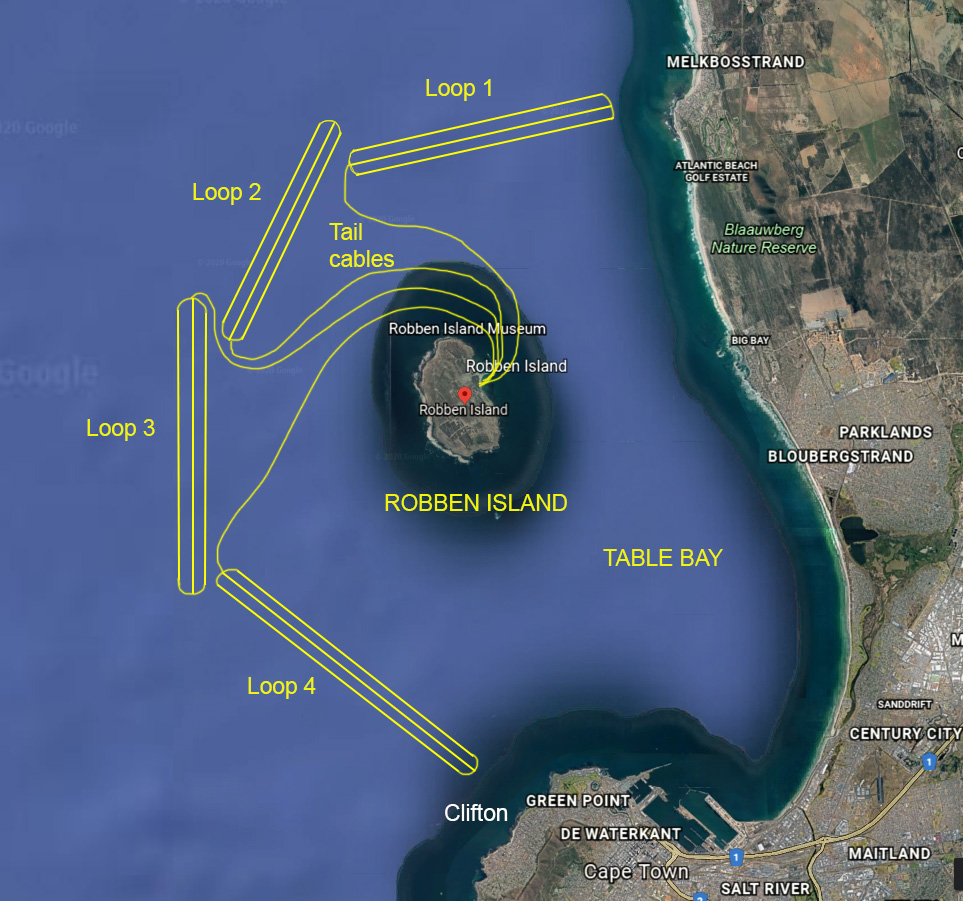 |
The Cape Town indicator loop layout |
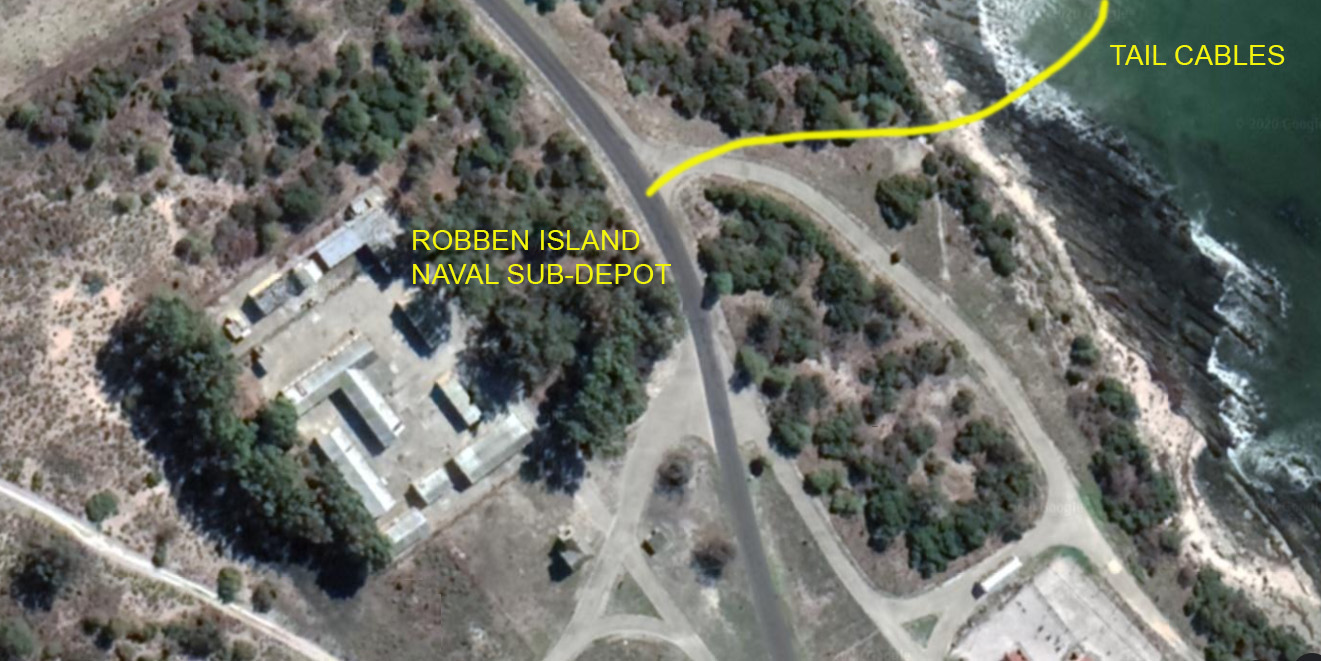
The Loop Control Hut was in the Naval Sub-Depot on the eastern side of Robben Island (Google Earth 1 July 2020)
My thanks to William Martinson - author of Robben Island Built Environment Conservation Manual - for additional details.
The loop defences at Durban were the next to be undertaken. The installation of the South African loop systems then proceeded slowly owing to cable-laying difficulties. It had been hoped that two vessels would be available, but the locally fitted Cecile Mapleson proved to be so unreliable that, after a series of breakdowns of her main engines, it was decided to replace her. For this the coaster Mead was requisitioned and fitted out by the Royal Navy, but she was completed only in time to take over from HMS Emile Baudot which sailed for Colombo in January 1943 after carrying out a preliminary survey at Durban. HMS Mead then began to lay the Durban indicator loops which formed a rough semicircle, beginning about a mile south of the Bluff and ending seven miles north of it, near Umhlanga Rocks, where the control station was situated (about eight miles away). This work, which entailed the accurate laying of nearly 140 miles of cable in unsheltered waters, was completed by the middle of April and the Umhlanga Naval Station - one of the largest and most exposted installations of its kind in the world - went into operation in June 1943. Five HDAs (type 131) had been added by the end of October, but only three of these were effective. Seven loops, again each 6 km long were laid, but because only one cable-laying vessel was available, this was not completed until April 1943. The control hut was located at Umhlanga Rocks, 7 miles North of Durban Bluff.
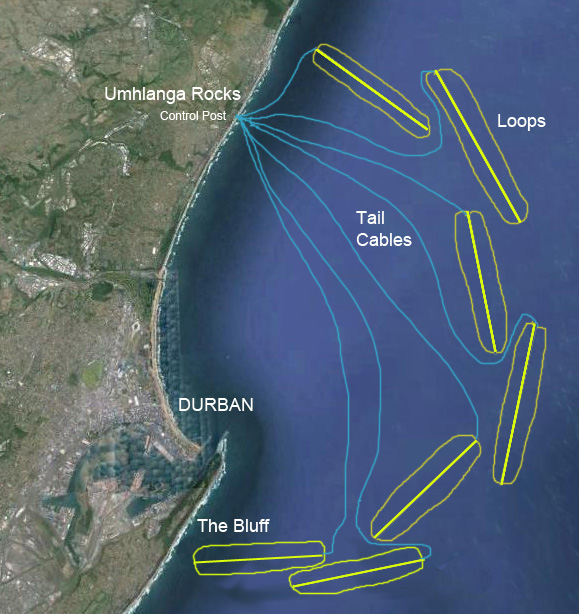 |
Durban loop layout |
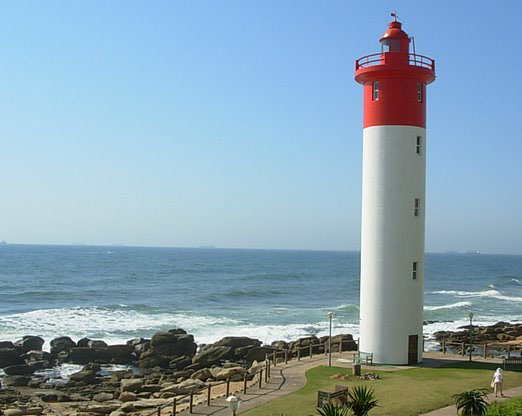 |
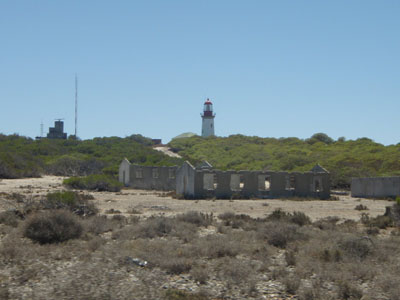 |
Umhlanga Rocks Lighthouse - today |
Robben Island
lighthouse and WW2 barracks - today |
Meanwhile, the entrance to the major port of Saldanha Bay (110 km NW of Cape Town) had a control building was completed at the end of 1942; but no vessel was then available to lay the loops and this was never afterwards effected, partly owing to the greatly reduced importance of the harbour by the middle of 1943, and also because strong defences of other kinds - a controlled minefield and extensive A/s booms - were already being installed there. This minefield consisted of eight rows of mines, each surrounded by a 'mine loop' (similar to an indicator loop) and a few hundred metres to the ocean side were eight 'guard loops' ready to make the first detection of any submarine.
The next scheme was to provide indicator loops at Walvis Bay, but changes in the general war situation caused this to be cancelled in September and a complete system of A/S Fixed Defences, planned for Simon's Town, never materialised for the same reason. It was therefore decided, at the end of 1943, that the third (and last) South African loop system would be installed at Port Elizabeth and HMS Mead was sent there as soon as she had completed certain cable repairs at Durban and Cape Town. The first two loops were laid in January 1944 and the installation, consisting of seven short loops connected to a control station on the end of the Chari Malan Quay, came into full operation on 27th March.
As soon as each loop system was completed it was closely linked up with the other defences, through the local Fortress Command Operation Room. Thus, in the event of a loop-crossing, one or more patrol vessels could be sent forthwith to investigate it; at night or in low visibility (when the crossing might be caused by a surface vessel) it also served as a "standby" to the shore batteries and searchlights. Early in 1943, two non-operational British submarines were allocated to the South Atlantic station; of these, P614 carried out practical tests of the Table Bay A/S defences on 30th March and OTUS did so later at Durban. Crossings by friendly surface vessels, for which a permanent visual watch was kept, also, of course, produced signatures on the recording instruments, so that the watch keeping personnel soon became quite familiar with these.
Although these elaborate and costly installations probably acted as an excellent deterrent, there was no definitely established instance of an enemy submarine crossing them at any South African port during the war. There were however two distinct unidentified crossing of the Cape Town loops on 13th February and 20th May 1943, when U-boats were known to be in the area. On both occasions patrol vessels obtained brief contacts which were not repeated, possibly owing to the poor A/S conditions prevalent in these waters, caused by the large variations of temperature at different depths. The unidentified signature in May was followed, a few hours later, by a second one which strongly suggested that an enemy submarine had in fact entered, waited on the bottom, and then left without taking offensive action. There were also numerous false alarms, particularly under conditions in which the visual watches were ineffective.
While arrangements were being made for the protection of the anchorages, further precautions were taken against the penetration of the inner harbours at Cape Town and Durban by midget submarines by supplementing the existing home-made "Goodlet" loops with H.D.A.s (type 135). At Durban, the pair of 135sinstalled at the outer end of the entrance channel were working satisfactorily by May 1943, but at Cape Town considerable difficulties were encountered and the two pairs (one for each dock entrance) were not in operation until July. Even then, these H.D.A.s were subject to much interference from dredgers, boom defence wires and high-power electric cables in or near the harbour entrances, so that breakdowns and non-operational periods were frequent. Another weakness, especially troublesome at Cape Town, was that the instruments were affected by shoals of fish passing through the entrances and this gave rise to many false alarms. Type 135s were also mounted in the harbour entrances at Port Elizabeth in March 1944 and at East London in September of that year, the latter being the only kind of A/S Fixed Defence installed at the mouth of the Buffalo River.
Owing to accommodation difficulties and to the comparatively small numbers employed, the W.A.N.S. did not take over watch keeping duties at the Type 135 Stations at Cape Town, Durban and East London which were therefore manned by S.A.N.F. ratings until they closed down in 1945.
To defend the inner harbours of Durban and Cape Town against midget submarines, frogmen and similar attackers, depth-charge throwers were mounted at the entrances. These were activated on information received from the indicator loop officers. Later in the war, the depth-charge throwers relied on signals from the harbour defence Asdics (HDAs). Similar defences (indicator loops, HDAs) were to be installed at Port Elizabeth and East London in 1944 although it appears the Port Elizabeth loop defences may have been reallocated to Walvis Bay (a part of South Africa during WW2 but now in Namibia). A personal account of life with the SA Naval Force during WW2 is provided in Lt Andrew Murray McGregor's fascinating memoirs, an extract of which appears below.
Further attacks
The first real threat by German U-Boats came in August 1942 when Admiral
Donitz ordered four U-Boats (and a U-Boat oil tanker) to proceed to Cape Town
but also ordered them to attack any allied shipping they may come across. These
U-Boats had been successfully operating off the US East Coast but better A/S
defences by the US Navy (including USN indicator loop defences at a dozen or more
ports) reduced the U-Boats' effectiveness and better hunting grounds were
sought. Admiral Donitz thus turned his attention back to the Atlantic.
The Japanese too had entered the war. However, by now, the South African naval defences were having a rather monotonous time. There was some excitement on the night of 1/2 June 1944 when the indicator loops at Saldanha Bay reacted to two crossings but no evidence of underwater craft were found.
Conclusion
Naval operations in the southern oceans adjoining South Africa ended in early
1945. Within 1000 miles of the Union the losses were one allied warship (the
Dutch submarine depot ship Colombia) and damage to the British depot ship
Hecla. Merchant losses from submarines amounted to 133 ships (117 sailing
independently, 15 in convoy, and 1 straggler) - 750,000 tons. Raiders accounted
for 20 ships and mines for 2 ships. The strategic significance of the Cape has
been recognised by historians (see "War in the Southern Oceans 1939-45" by L. C.
F. Turner & J. E. Betzler, OUP, Cape Town, 1961); the Cape route was the only
link between Britain and India and the far East for almost three years, and its
severance would have brought about collapse of the Allied effort in the Middle
East. That the allied losses were not greater around the Cape is regarded as a
tribute to the fine qualities of the men and women who fought for the cause.
ACKNOWLEDGEMENTS. Much of the material in this webpage comes from "Unpublished chapters from the official history of the SA Naval Forces during the Second World War", by Cdr HR Gordon-Cumming. Scientia Militaria, South African Journal of Military Studies, Vol 22 (1), 1992. [http://scientiamilitaria.journals.ac.za].
Extract from Lt Andrew
Murray McGregor's
Memoirs
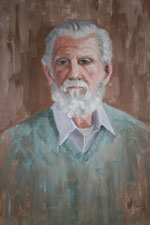 |
The extract below comes from the memoirs of the late Andrew Murray McGregor
(1908-2002), prepared as a webpage by his son Tony to whom I am grateful for his
permission to reproduce a small part. His father Andrew Murray McGregor
was born in Worcester, Cape Province, on 26 May 1908, when the Province was
still a colony of Great Britain. He died in 2002, having lived through two World
Wars, the unification of the four British colonies into the Union of South
Africa, the exit of apartheid South Africa from the British Commonwealth of
Nations in 1961, when it became a republic, and its increasing isolation from
the rest of the world, and then the birth of a new, non-racial democratic
country after April 1994, which once again joined the British Commonwealth of
Nations.
Early 1942.....
After a safe but boring journey to Cape Town I reported to Naval HQ .........
Four of us "oldies" were sent to the new anti-submarine base on Robben Island where we immediately began a new course in electrics, as the introduction to our anti-submarine course. Thereafter we learnt about the "loops" that had been laid in a huge semi-circle from Melkbos Strand in the North to Clifton in the West, all circling Robben Island. Each loop (there were four of them) consisted of three lengths of cable, each about five miles long, all parallel with each other and joined at the ends. From one end of each loop there was a thinner cable to connect the loop to the instruments in our base, which was called the Naval Sub-Depot, Robben Island, so that its real function could be kept secret. For the same reason the buildings in which the instruments were set up and the other buildings which housed all the naval personnel were built among trees and bushes to hide them from the sea or the air. A thin steel lattice mast with steps on it was used by the people on look-out duty.To begin with the erection, fitting out and staffing of the "NS-D,RI" was in the hands of RNR or RNVR officers and ratings. I was in the first class of SANF officers to do the Anti-Submarine Fixed Defences course here. The course lasted some eight weeks, if my memory is correct, and there were about a dozen or twenty in the course. Two of our number failed the final tests and were returned to ‘General Service'; four of us were kept on Robben Island and the other successful candidates sent to start new A/S F/D bases or to join existing bases in the other seaports around our coast.
The RNVR officer in charge of all this land-borne anti-submarine work, whose title was "Anti-Submarine Fixed Defences, South Atlantic" and who was thus always referred to as "ASFIDOSA", received an order from the Admiralty in London to scrap the plan for the erection of an anti-submarine fixed-defences base in Port Elizabeth and instead to do so in Walvis Bay. The reason was that the Japanese had begun to make attacks in Madagascar and had even sent a large submarine which carried a seaplane to make a scouting trip to Durban, during which the seaplane flew over the harbour and the town, causing the first air raid alarm signal there. This alarmed the authorities in South Africa and also in London, as it was feared that that island and the south-eastern part of South Africa might be the region for the next Japanese attack on the Allies, so it was decided to scrap the idea of building a new A/S F/D base in Port Elizabeth and instead to set it up in Walvis Bay. I was chosen to do this, so I had to go by train from Cape Town to Port Elizabeth and to see to the embarkation of all the A/S F/D gear, which had been landed there but not yet used, into a Danish cargo ship, the MS Tureby, a 4500-tonner which had already taken aboard much cargo destined for Britain.
The easiest part of this job was to put aboard the cartons in which the A/S detection instruments were kept. As they were very much "official secrets" it was decided to put them into the cabin destined for me, so that I could lock them into it and keep the key myself. Incidentally, they filled the cabin so completely that I could not use it myself, thus I had to sleep on a cushioned bunk in the officers' dining saloon and use the captain's bathroom which was next to it. The biggest and most tiring part of the operation was to deal with the undersea cable, some 50 miles of it, which weighed over 4 tons per mile. The core of this cable was the usual copper wire for taking the current, but this had to be securely insulated from the sea water by a covering of thick rubber and, as that had to be protected from breaking, this was all covered with a thick layer of steel wires and that by a coating of canvas which had been water proofed by being soaked in tar for a long time! All this meant that the cable had a diameter of about three inches.
We had to pay the cable out from its huge coil on the dockside, a coil that had to have an inside diameter of at least 20 feet, to prevent the cables being bent sharply enough to break it. The diameter of the coil on the outside was about 40 feet and its height over 8 feet. We had to lift the cable and uncoil every foot of it, bring it over to the top of No 3 hatch and re-coil it in the hold. We had to work night and day without stopping for 12 days, with several different groups of labourers. When all the cable had been transferred from the coil on shore to the coil in the ship's hold there was another task to see to, the building of a timber "wall" all round the coiled cable. The outer sides of this wall being held in place by balks of timber fixed between them and the ship's steel sides.
When all this had been done, the Tureby's captain got his orders from SANOIC, the SA Navy's senior officer in Port Elizabeth, to join a coastal convoy that was to pass Port Elizabeth on its voyage from Durban to Cape Town. This we did. The merchant ships in the convoy were drawn up in three rows of five ships each, with a destroyer zig-zagging in front of them, a corvette doing the same right aft and a whale catcher turned into a submarine chaser on each broadside. On the first evening out, as I was at dinner with Captain Lohse, his chief officer and the chief engineer, all very friendly Danes, we were nearly thrown off our chairs by a tremendous shaking of the ship followed by a tremendous noise. We all rushed up to the top of the superstructure and, looking aft, saw the corvette and one of the whale catchers going round in circles and dropping depth charges, with the destroyer rushing round from the front of the convoy to join in the fun. The merchant ships were ordered to keep going at full speed. We soon left our escort behind but, about half an hour later, they caught up with us, the corvette signalling to us by lamp, "Sorry, just a school of porpoises." We were all very sorry for the poor porpoises but glad to know that there was not just then any danger from U-boats. Three days later we arrived in Cape Town, where all the ships filled up with extra cargo and with fuel for the long haul across the Atlantic.
As I had done well in the A/S courses that we had received and it was known at HQ that I was by profession a teacher I was told that I was to be an instructor-officer to various groups that were sent o Robben Island, our Sub-Depot being an instructional as well as an operational base. My first effort in this duty was to take a group of about a dozen SANF lieutenants and sub-lieutenants in the eight week's A/S F/D course. Then I had a six-week's course for Leading Seamen, a shortened, more practical course and later about three more officers' courses. During this time most of the RNVR officers had been returned to the RN and then Lieut. Perkins left Robben Island to become A/S F/D OSA in charge of all the A/S F/D stations round our coast. His promotion led to mine as, in addition to being the chief Instruction Officer on the Island I had to take over as Commanding Officer, S/D R/I.
If you have any further details of South African harbour defences naval bases that may help with this research project please email me at the address at the top of the page.
